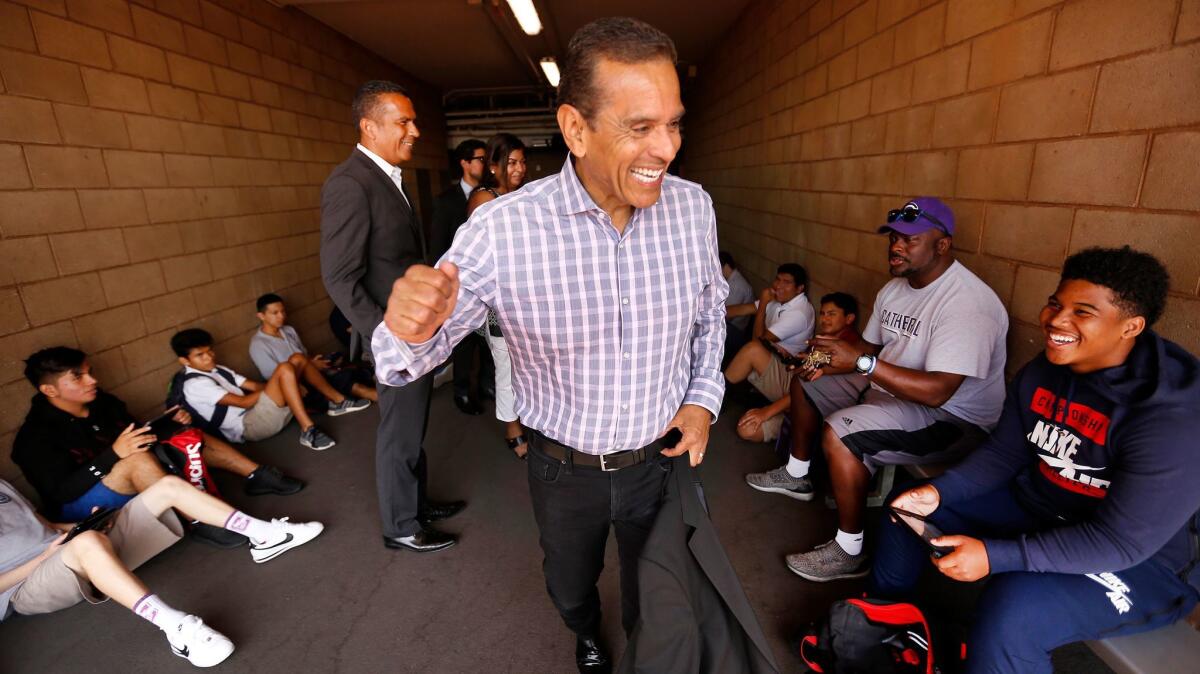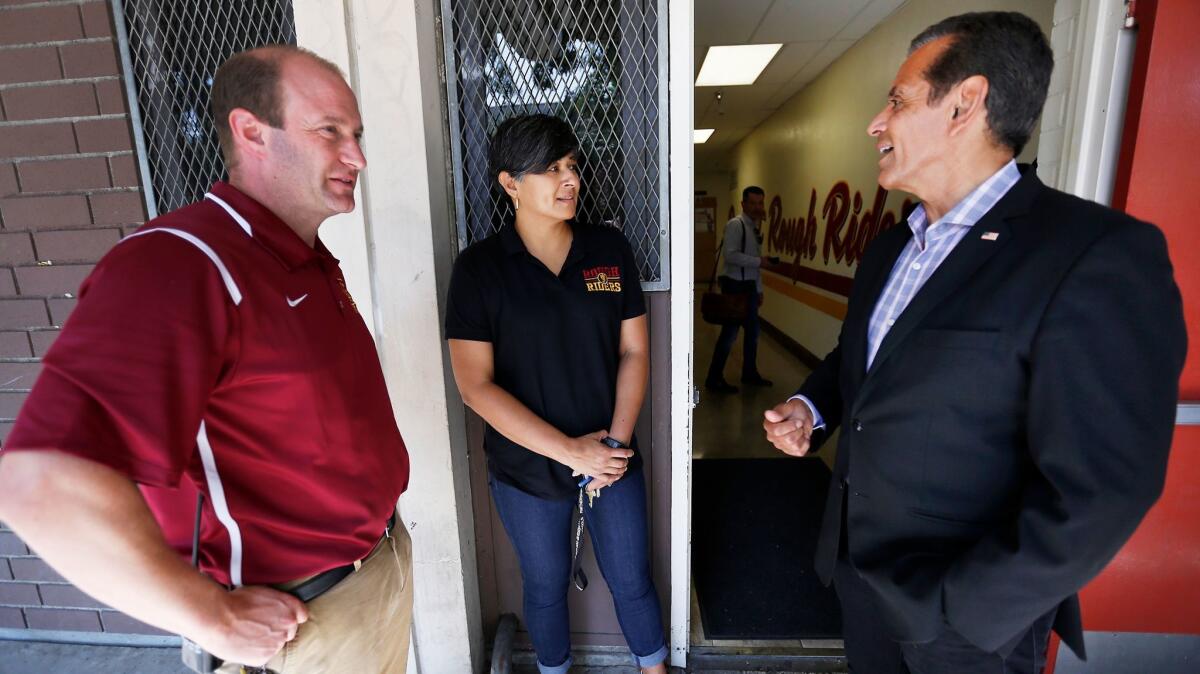How Antonio Villaraigosa went from a union organizer to a union target

Antonio Villaraigosa launched his political career as a union organizer in L.A. As mayor, he became one of labor’s biggest foes. Now, in the governor’s race, he will have to deal with the repercussions. (Al Seib / Los Angeles Times)
- Share via
Antonio Villaraigosa launched his political career off his work as a union organizer, and labor played a critical role in getting him elected to office. So it was a remarkable moment when Villaraigosa, as Los Angeles’ mayor, blasted the city’s teachers union where he once worked as “the largest obstacle to creating quality schools.”
Now, as Villaraigosa runs for governor, this evolution is the reason one of the state’s most powerful interests may try to sink his campaign.
“Unless a miracle happens … there’s going to be a lot of money put into efforts against Antonio,” said A.J. Duffy, the former president of United Teachers Los Angeles. “It’s going to be down and dirty.”
Villaraigosa is the most prominent Democrat in California to challenge the teachers unions, a fight that he has continued since leaving the mayor’s office in 2013. Since then, he notably sided with students in a lawsuit that argued that their state constitutional rights were violated by state laws regulating teacher layoffs, firings and tenure. The lawsuit initially triumphed but was later overturned.
There are potential benefits to his stance — donations from wealthy supporters of the education reform movement and the ability to cast himself as a man willing to stand up to one of his party’s most influential constituencies. Some argue that these are the very reasons Villaraigosa picked a fight with labor.
“He made a political calculation … that this was a way to further his political ambitions,” said one state education leader who will have to work with the next governor and did not want to be identified. “If you’re going to run for governor or senate, you want deep pockets supporting you.”
Villaraigosa declined to comment about the moneyed forces on both sides of the issue. But he argued his motivation is pure.
“I really wasn’t looking for a fight with anyone, and I’m still not, but I made it clear, I will fight for these kids,” he said in an interview at Dolores Mission, a Catholic elementary school he attended for two years. “Look at these kids. These kids can learn.”
Follow California politics by signing up for our email newsletter »
The rifts with labor emerged once he became mayor in 2005. He was labeled a “scab” when he crossed picket lines the following year during the first major city workers’ strike in a quarter-century. He later clashed with unions over furloughs and layoffs as the city grappled with the recession.
But tensions grew exponentially as the mayor unsuccessfully tried to seize control of the Los Angeles Unified School District, arguing that city schools needed to be dramatically overhauled because they were failing the neediest students. He eventually gained control of more than a dozen struggling city schools through a nonprofit he founded. He also shaped district policy by helping elect like-minded school board members.
He questioned policies fiercely guarded by teachers unions, such as seniority protections that resulted in constant layoff notices to the younger teachers who tend to staff the most challenging schools. He grew to support using student test scores to evaluate teachers and other overhauls anathema to union leaders.
Villaraigosa argues that he sought to work with the city’s teachers’ union and only criticized them when he had no other choice.
“I didn’t want to fight with them. I still don’t. I believe in teachers. I believe in collective bargaining,” he said. But “there was resistance to virtually everything we did. I wanted to partner, but they just fought us tooth and nail.”
UTLA representatives did not respond to a request for comment.
Joshua Pechthalt, the president of the California Federation of Teachers, worked at UTLA at the time and has known Villaraigosa for decades.
“I don’t think he saw it as being anti-union in any way, but being sensitive to kids like he was, and for us to block the kinds of reforms he was supporting was doing a disservice to those kids,” said Pechthalt. “I would disagree with him but I don’t think it necessarily came from a bad place.”
Villaraigosa’s fight is personal. He looks at the children playing dodge ball at Dolores Mission and sees himself.
The roots of Villaraigosa’s arc from union organizer to union critic can be traced to his upbringing in City Terrace, and the patchwork of public and private schools he attended in Boyle Heights and downtown. His passion for organizing was forged during the social upheaval of the 1960s and 1970s — as a teenager he led student walkouts at his Catholic high school and picketed in support of the farmworkers’ boycott at the supermarket where he worked.
But the seeds of his later-in-life criticism of teachers unions also were sown then, as he saw the opportunities that education could afford and the obstacles for underprivileged students.
Fights prompted by anger from his chaotic youth — when as a toddler he witnessed his alcoholic father beat his mother before deserting the family — and a spinal surgery as a teen led to his expulsion from Cathedral High School.
He was sent to Roosevelt High, a public school where one out of four graduated, and placed in basic reading and math classes and vocational training, despite the college-prep classes he had taken previously, he said. “This is what the counselor told me: ‘You look like a guy who wants to have fun. I’m going to give you classes that aren’t going to make you work very hard.’”

He grew bored and dropped out, worked and partied. Eventually, prodded by his mother and a teacher who saw a spark in him, Villaraigosa returned and graduated with a 1.4 grade point average. “It was a Catholic school that gave me a foundation, but it was public school that gave me a second chance,” he said.
That opportunity ultimately led to Villaraigosa’s earning a law degree and working at labor and civil-rights groups before launching his political career: six years in the state Assembly, including a stint as Assembly Speaker; two years on the city council; and eight years as mayor.
Along the way, labor buttressed his campaigns, donating millions of dollars and dispatching members to walk precincts, man phone banks and turn out voters.
Ultimately, Villaraigosa’s education legacy is viewed as mixed “when you drill down and take a look at actual accomplishments,” said former state Sen. Gloria Romero, who was the state leader of Democrats for Education Reform. She said he did make “some very good strides and great progress.”
When Villaraigosa left office in 2013, a Times analysis found that the mayor’s schools overall performed comparably to district schools with similar demographics, though some saw notable improvements.
Villaraigosa argues that change takes time and points to the graduation rate at his alma mater. When he took office, Roosevelt’s graduation rate was 36%; the class that graduated earlier this year is expected to be in the high 80s.

Villaraigosa’s fight with the teachers unions occurred at a time there was a growing rift among Democrats nationally about education. Teachers unions have historically been among the party’s most stalwart supporters but some – notably then-President Barack Obama — questioned their priorities.
The growing divide was not as visible in California, where the California Teachers’ Assn. had long been one of most powerful forces in state politics.
That’s why Villaraigosa may have reason to be concerned: In 2014, CTA spent $12 million to defeat Marshall Tuck, a huge sum in an obscure race to be state superintendent of public instruction. Tuck is a Democrat and former charter school leader whom Villaraigosa hired to run the nonprofit that oversaw his schools. If CTA and other teachers unions decide to go after Villaraigosa, they could paint him as on the same side of the education debate as corporate interests and Republicans rather than teachers and Democrats. Or they could support his top Democratic rivals in the race, Lt. Gov. Gavin Newsom and state Treasurer John Chiang, who have less controversial records on K-12 issues.
Follow the money race in the governor’s race on our fundraising dashboard »
The upside for Villaraigosa is that education reform efforts are supported by politically active millionaires and billionaires, and his 2018 campaign has already received financial support from these donors. Others have funded his efforts to shape the city’s school board. A critical question will be whether such donors fund an independent effort to boost Villaraigosa’s campaign, as they did for Tuck in 2014.
CTA president Eric Heins and the CFT’s Pechthalt declined to comment on their organizations’ plans, saying they would announce endorsements later this year. The race is a priority given the governor’s influence on funding, accountability, curriculum and other policy.
“Naturally we’re going to be very concerned about who gets elected to that seat and look at their record,” Heins said.
For the latest on national and California politics, follow @LATSeema on Twitter.
Live coverage of California politics
More to Read
Get the L.A. Times Politics newsletter
Deeply reported insights into legislation, politics and policy from Sacramento, Washington and beyond. In your inbox three times per week.
You may occasionally receive promotional content from the Los Angeles Times.











